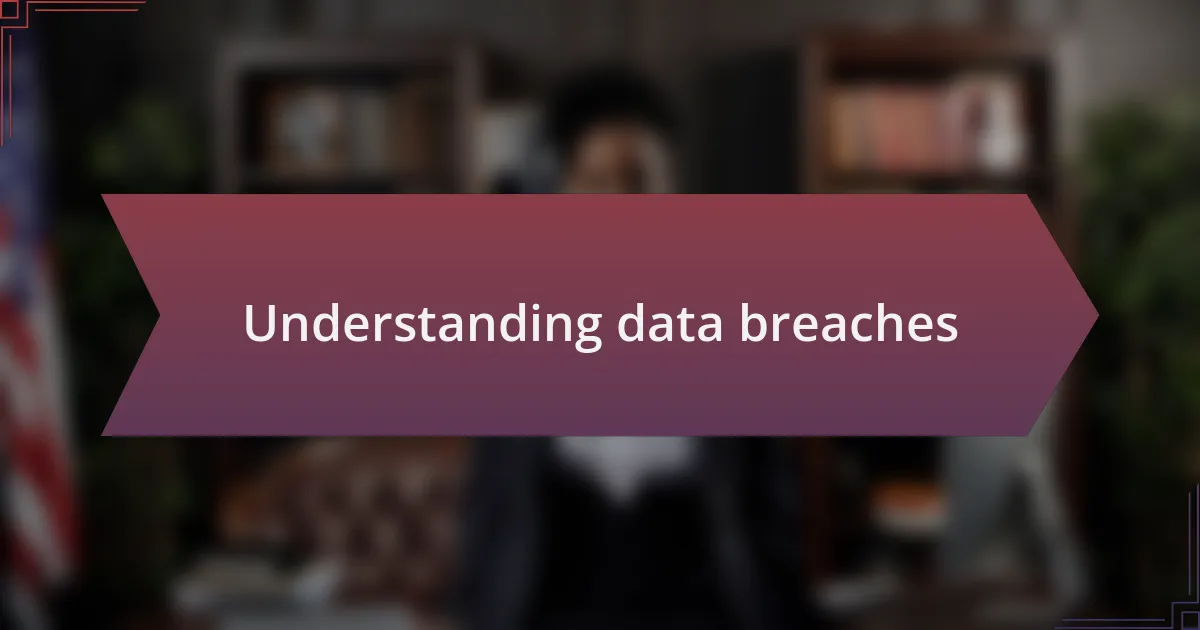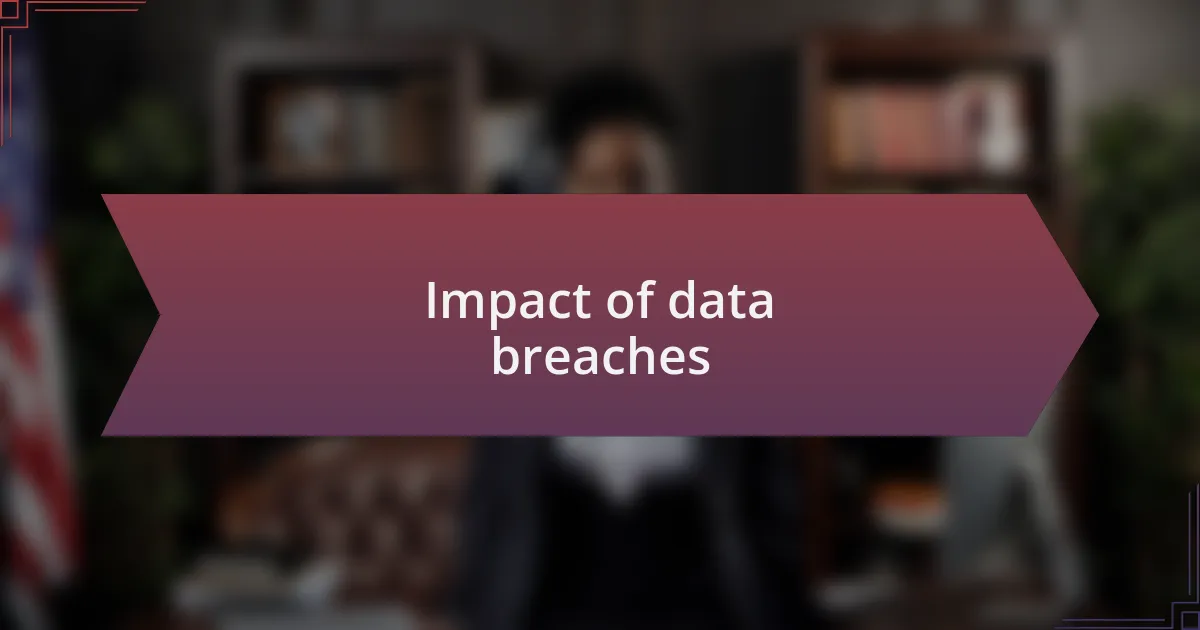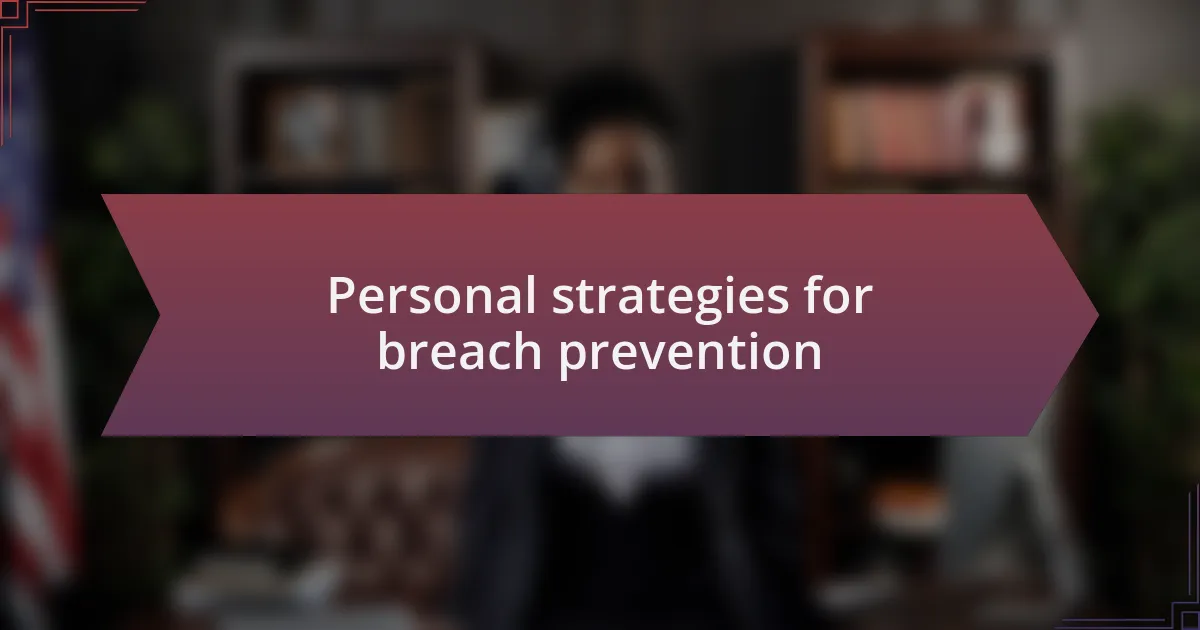Key takeaways:
- Data breaches expose sensitive information and can significantly damage trust between organizations and their clients.
- Employers must comply with data protection laws, implement robust security measures, and communicate transparently with employees during breaches.
- Continuous training and awareness are crucial for preventing breaches, with emphasis on proactive measures and incident response plans.
- The emotional impact of breaches can affect employee morale and organizational culture, highlighting the need for support and resilience.

Understanding data breaches
Data breaches occur when sensitive, protected, or confidential information is accessed, disclosed, or used without authorization. I remember the unease I felt when I learned about a major breach at a company I had previously worked for. It was a stark reminder that our personal data can be vulnerable, and it made me wonder how many people were affected by that situation.
Understanding the types of data breaches is crucial for effective management. For instance, breaches can stem from cyberattacks, insider theft, or even accidental exposure. Reflecting on my experiences, I’ve often thought about how small oversights, like clicking on a phishing link, can lead to significant consequences for both individuals and organizations.
It’s also important to recognize the impact a data breach can have on trust. Once that breach occurs, the relationship between the company and its clients can be irrevocably changed. I often ask myself, how can a company regain that trust? The answer lies in transparent communication and swift action, but the road to recovery can be challenging.

Impact of data breaches
Data breaches can have profound effects beyond just the immediate loss of information. I recall a colleague who faced significant anxiety after her data was compromised; it felt like her privacy had been invaded. This emotional toll can lead to decreased productivity and heightened stress levels, affecting not only the individuals involved but also the organization as a whole.
The financial ramifications of a data breach can be staggering. Companies may incur hefty costs related to legal fees, regulatory fines, and remediation efforts. In my experience, the outrage from clients can lead to not just financial loss but also a diminishing market reputation. I often wonder, what’s worse: the direct cost of the breach, or the long-term damage to a brand’s credibility?
Furthermore, the ripple effects of a data breach can impact employee morale. When an organization is compromised, I’ve seen firsthand how staff can feel insecure and distrustful about their own handling of sensitive data. How do we nurture a secure environment again? It often requires a cultural shift towards greater awareness and training, which, while essential, can be a long and arduous journey.

Legal obligations for employers
Employers have a clear legal obligation to protect the personal data of their employees. When I was part of a compliance team, I witnessed how important it was for companies to understand the intricacies of data protection laws, such as the General Data Protection Regulation (GDPR). Failing to comply with these regulations can lead not only to financial penalties but also to a damaged reputation that can linger for years.
It’s crucial for employers to implement robust data security measures, from regular training sessions on best practices to ensuring that sensitive information is encrypted and securely stored. I remember when a company I consulted for enhanced its data protection strategies after realizing how easily employees could inadvertently expose sensitive information. It wasn’t just about meeting legal requirements; it also fostered a culture of trust within the workplace.
Employers must also be proactive in communicating with employees when breaches occur. I’ve seen how transparency can significantly reduce anxiety among staff. When a breach happened at my previous workplace, management quickly informed us through a comprehensive communication plan. It made a notable difference in how we felt about the incident—being informed felt empowering rather than frightening. How can we expect employees to feel secure if they are kept in the dark?

Best practices for data management
Best practices for data management involve a multi-layered approach tailored to the specific needs of an organization. From my experience, having a clear data classification system helps employees understand which information is sensitive and requires additional protection. I once worked with a firm that implemented color-coded labels, making it visually clear what could be shared and what must remain confidential. This simple technique fostered a culture of responsibility.
In addition to clear classification, regular audits of data access and usage are essential. During a course of audits I conducted, we discovered several outdated permissions that allowed former employees access to sensitive data. This revelation shocked the team, but it underscored the importance of routinely revisiting who has access to what data. How often do we take stock of our data security?
Furthermore, prioritizing employee training on data management practices cannot be overstated. I’ve observed that hands-on workshops, where employees participate in simulated breach scenarios, create a sense of urgency and awareness about potential threats. It humanizes the process rather than treating data protection as a checkbox item. When employees can vividly understand the implications of data breaches, they become more vigilant. Are we doing enough to prepare our teams for the challenges ahead?

Personal strategies for breach prevention
When it comes to preventing data breaches, I’ve found that establishing a strong password policy is crucial. For a project I led, we mandated the use of complex, unique passwords that changed every three months. Initially, there was resistance from team members, but over time, they realized the enhanced security provided peace of mind—nobody wants to be the reason for a breach, right?
Another effective strategy I’ve implemented is encouraging open communication about potential vulnerabilities. In one team meeting, I shared a story about a close friend who faced a data breach due to a simple phishing email. The dialogue that followed opened everyone’s eyes to the subtle ways information could be compromised. It made me wonder: are we truly fostering an environment where employees feel comfortable discussing their concerns?
Additionally, I’ve invested time in creating a robust incident response plan. The first time we faced a minor breach, having a clear action plan helped us respond swiftly, which ultimately minimized damage. It’s a reassuring feeling to know that if something goes wrong, you’re not scrambling in the dark—you have a strategy to navigate the chaos. How prepared are we for the unthinkable?

Responding to a data breach
When a data breach occurs, the initial response is critical. I recall a time when we encountered an unexpected breach late at night. Given our incident response plan, we jumped into action, mobilizing the team for a rapid assessment. That adrenaline-fueled night taught me the importance of having clear roles established ahead of time; it minimizes chaos and ensures that everyone knows their responsibilities when urgent decisions need to be made.
Communication is another key aspect of effectively responding to a data breach. After our incident, I organized a debriefing session. Seeing my colleagues’ concern transform into proactive discussions about our security posture was eye-opening. It raised a pertinent question: how often do we prioritize transparency and learning over blame in these situations? I firmly believe that fostering a culture of openness leads not only to improvements in security measures but also strengthens team trust.
Finally, I learned that notifying affected parties promptly is essential. During the breach we experienced, we had to inform our clients about potential risks. It was an emotional moment; the weight of those notifications weighed heavily on my shoulders, but I realized it was necessary. How would I feel if the roles were reversed? Understanding the impact on others helps reinforce the need for transparency, fostering a greater sense of accountability and compassion within the organization.

Lessons learned from past experiences

Lessons learned from past experiences
One of the most significant lessons I’ve learned from past breaches is the value of continuous training. I remember participating in a cybersecurity workshop after a colleague mistakenly clicked on a phishing email. The realization of how a single lapse could lead to serious repercussions was sobering. It raises a crucial question: are we doing enough to ensure our teams are equipped with the knowledge to recognize threats before they become crises? Investing in ongoing education has become a cornerstone of our strategy, making every team member an active participant in safeguarding our data.
In another instance, I experienced firsthand the repercussions of a lack of thorough risk assessment. We assumed our firewalls were impenetrable, only to discover a vulnerability that left us exposed. That moment was a humbling lesson in complacency. It made me reflect: how often do we become overconfident in our defenses? This incident reaffirmed my belief that regular security audits and external reviews are necessary. They provide fresh perspectives and often reveal blind spots that we might overlook in our daily responsibilities.
Lastly, the emotional toll of a breach can be profound. I recall feeling the weight of responsibility for my team’s anxiety after we learned about a data leak. It made me think about the importance of mental resilience in crisis management. How do we prepare ourselves and our colleagues to handle the emotional fallout? Acknowledging the stress and supporting each other through these challenging times fosters a culture of resilience, which is vital when faced with the aftermath of a breach.